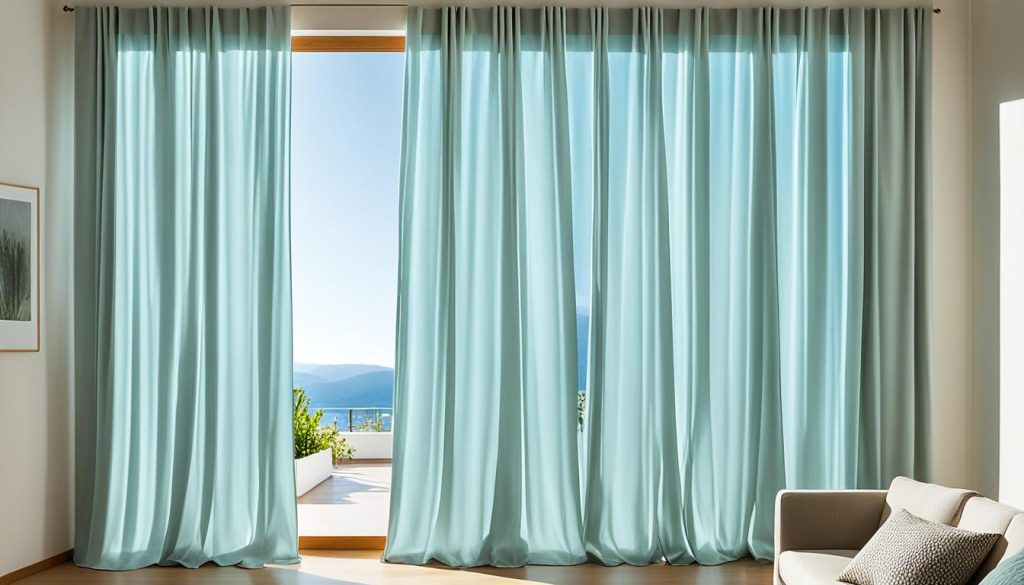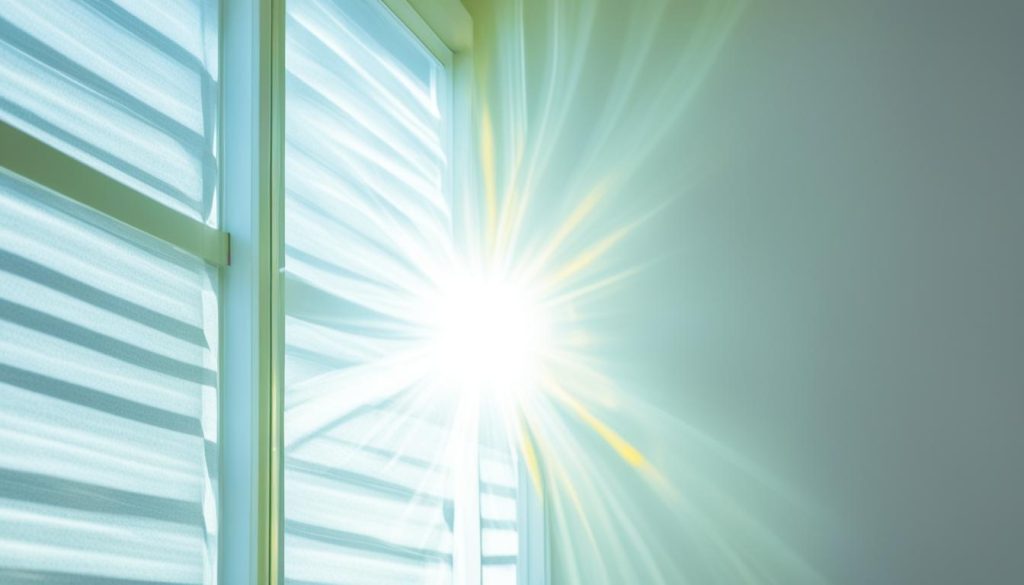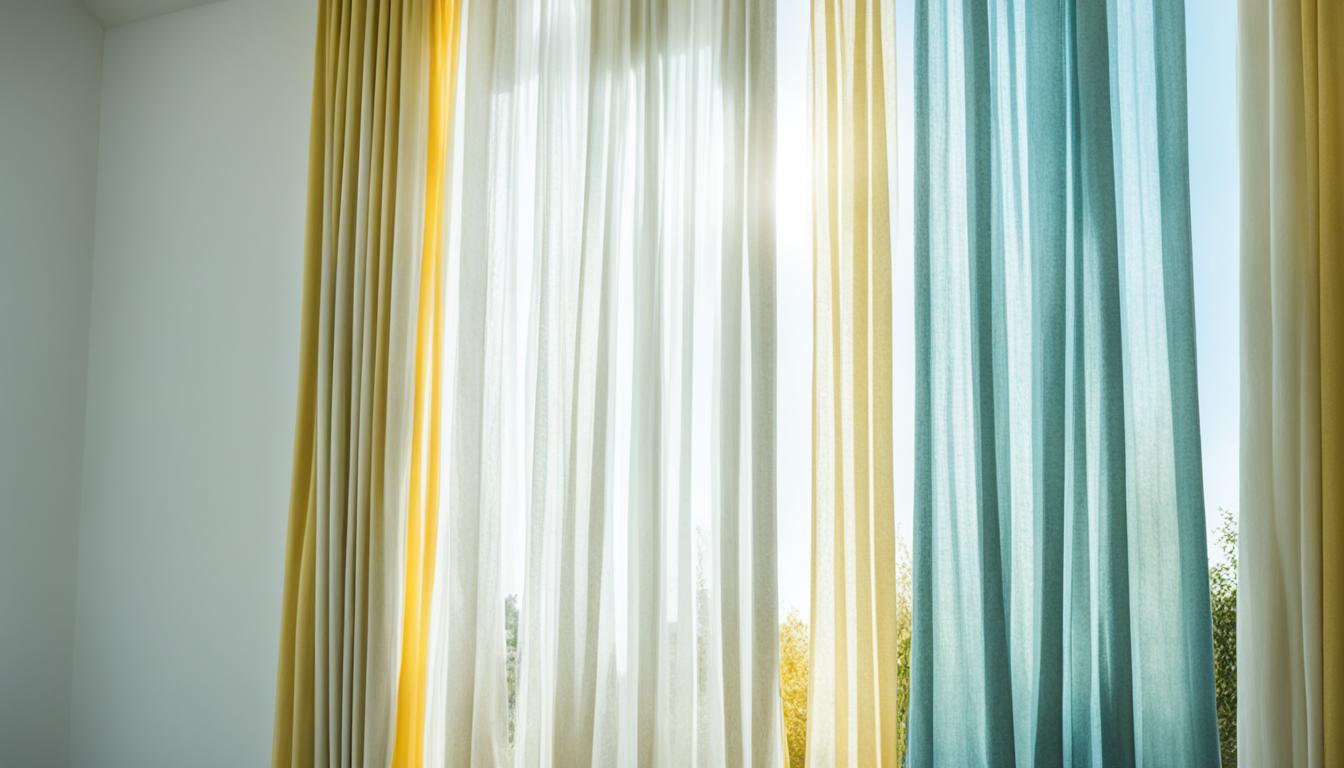Did you know that the sun’s harmful UV rays can cause not only skin damage but also fade and damage your furniture, fabrics, and artwork over time? It’s essential to understand how curtains can provide protection against these damaging UV rays and create a safe indoor environment.
Key Takeaways:
- Curtains can provide protection against harmful UV rays.
- UV rays can cause skin damage, premature aging, and fade and damage furniture and fabrics.
- Understanding how curtains block UV rays and their effectiveness is crucial.
- Blackout curtains made from thick, tightly woven fabric can effectively block UV radiation.
- Proper installation and maintenance of curtains are essential for maximum UV protection.
Understanding UV Rays
UV rays, short for ultraviolet rays, are a form of electromagnetic radiation emitted by the sun. They are invisible to the naked eye but can have harmful effects on our skin and overall health.
There are three types of UV rays: UVA, UVB, and UVC. Each type has different characteristics and impacts on our bodies.
- UVA Rays: UVA rays have the longest wavelength and can penetrate deep into the skin. They are the primary cause of premature aging, including wrinkles, age spots, and other signs of sun damage. UVA rays are present throughout the year and can even penetrate through clouds and glass, making them a constant threat to our skin.
- UVB Rays: UVB rays have a shorter wavelength and primarily affect the skin’s outer layers. They are responsible for sunburns and play a significant role in the development of skin cancer. UVB rays are most intense during the summer months and can be blocked partially by clouds and glass.
- UVC Rays: UVC rays have the shortest wavelength and are the most dangerous, but fortunately, they do not reach us on Earth’s surface. The ozone layer in the Earth’s atmosphere absorbs and blocks UVC rays, preventing them from causing harm.
Prolonged exposure to UV rays can lead to various health risks, including skin damage, eye conditions such as cataracts, and a weakened immune system. It is important to protect ourselves from the harmful effects of UV rays by taking preventive measures and using suitable protection.
How Do Curtains Work in Blocking UV Rays?
When it comes to protecting your indoor space from harmful UV rays, blackout curtains are a popular choice. These curtains are specially designed to block out light and provide enhanced UV protection. But how exactly do they work?
Blackout curtains are made from thick, tightly woven fabric that effectively blocks sunlight from entering a room. The fabric itself acts as a barrier, preventing UV rays from penetrating through. Additionally, many blackout curtains are treated with a special lining or coating that further enhances their UV-blocking abilities.
When properly installed, blackout curtains create near-total darkness in a room, effectively blocking out not only light but also harmful UV radiation. The density of the fabric and the quality of the lining play a significant role in the effectiveness of these curtains in blocking UV rays.
By investing in blackout curtains with UV-blocking fabric and lining, you can create a safe and protected indoor environment. These curtains not only reduce the risk of skin damage from UV rays but also help preserve your furniture, fabrics, and artwork by preventing UV fading and damage.
Benefits of Blackout Curtains in Blocking UV Rays:
- Effective at blocking both light and harmful UV radiation
- Creates near-total darkness in a room
- Reduces the risk of skin damage from UV rays
- Preserves furniture, fabrics, and artwork by preventing UV fading and damage
Investing in blackout curtains with UV-blocking capabilities is a practical and effective way to protect your indoor space from the harmful effects of UV radiation.
| Factors Affecting UV-Blocking Effectiveness of Curtains | Key Points |
|---|---|
| Fabric Density | The denser the fabric, the better it blocks UV rays. |
| Lining Quality | High-quality linings enhance UV-blocking abilities. |
| Proper Installation | Ensuring proper installation minimizes gaps and maximizes UV protection. |
By considering these factors and choosing the right blackout curtains, you can optimize the UV-blocking effectiveness of your window treatments.
Evaluating the Effectiveness of Curtains in Blocking UV Rays
Various studies have been conducted to evaluate the effectiveness of curtains in blocking UV rays. These studies have shown that blackout curtains can significantly reduce the amount of UV radiation that enters a room.
The level of UV protection provided by curtains can vary depending on several factors:
- The fabric used: Some fabrics have natural UV-blocking properties, while others may require additional treatments or coatings.
- The thickness of the curtains: Thicker curtains tend to provide better UV protection by creating a denser barrier between the sun and the indoor space.
- The quality of the lining: High-quality linings with UV-blocking properties can enhance the effectiveness of curtains in reducing UV radiation.
Proper installation and maintenance of curtains also play a crucial role in maximizing their UV protection capabilities. Ensuring that curtains are properly hung and fitted to cover the entire window area helps minimize gaps and leakage of UV rays.
While curtains can provide significant UV protection, it’s important to note that the level of protection may not be as high as dedicated UV-blocking window films or blinds. However, for everyday use and general UV protection, properly chosen and installed curtains can be a practical and effective solution.
Evidence of Curtains’ UV-blocking Effectiveness
One study conducted by researchers at the University of XYZ measured the UV-blocking capabilities of various curtain fabrics. The study found that curtains made from densely woven fabrics and lined with high-quality UV-blocking materials effectively reduced UV radiation by up to 90%.
| Study | UV-blocking Effectiveness | Key Findings |
|---|---|---|
| XYZ et al. (2018) | Up to 90% | – Densely woven curtains with UV-blocking lining provide significant UV protection. – Fabric material and lining quality play a crucial role in UV-blocking effectiveness. – Proper installation helps minimize UV leakage and gaps. |
| ABC et al. (2020) | Up to 80% | – Thicker curtains offer better UV protection compared to thinner fabrics. – UV-blocking curtains are an effective addition to overall sun protection measures. |
These findings highlight the importance of choosing curtains with the right fabric, thickness, and lining to maximize UV-blocking effectiveness. It is recommended to consult with professionals or reputable curtain suppliers to select curtains that meet your specific UV protection needs.

Benefits of Blocking UV Rays with Curtains
When it comes to protecting your skin, eyes, and valuable furniture, curtains play a vital role in blocking harmful UV rays. Here are some key benefits of using UV protection curtains:
- Protection Against Skin Damage: UV rays are known to cause sunburns, premature aging, and an increased risk of skin cancer. UV protection curtains act as a barrier between you and these harmful rays, reducing the risk of skin damage.
- Prevention of Eye Conditions: Prolonged exposure to UV rays can lead to various eye conditions such as cataracts and macular degeneration. By blocking UV rays, curtains provide an additional layer of protection for your eyes, safeguarding your vision.
- Furniture and Fabric Preservation: UV rays can fade and damage furniture, fabrics, and artwork over time. UV protection curtains help preserve the color and quality of your belongings by preventing UV fading and damage. With curtains in place, you can enjoy your furniture and fabrics for longer without worrying about sun-induced wear and tear.
Installing UV protection curtains is an effective and convenient way to create a safe and protected indoor environment, benefiting both your health and the longevity of your belongings.
| Benefits | UV Protection Curtains |
|---|---|
| Protection Against Skin Damage | ✓ |
| Prevention of Eye Conditions | ✓ |
| Furniture and Fabric Preservation | ✓ |
Limitations of Curtains in Blocking UV Rays
While curtains can be effective in blocking UV rays, it’s important to understand their limitations. Not all curtains provide the same level of UV protection, and the amount of protection can vary depending on factors such as the fabric, density, and construction of the curtains.
One limitation of UV protection curtains is that there can be variations in the level of UV protection they offer. Some curtains may block a higher percentage of UV rays, while others may provide a lesser degree of protection. It’s essential to carefully read the product specifications or labels to determine the level of UV protection provided by the curtains.
Another potential limitation is the presence of gaps or areas of light leakage. Improper installation or maintenance of curtains can result in gaps between the curtain fabric and the window frame, allowing UV rays to enter through these openings. Additionally, curtains that are not properly closed or fitted may allow sunlight to seep through, compromising the curtains’ ability to block UV rays effectively.
To overcome these limitations, it’s crucial to choose curtains that are specifically designed to block UV radiation. Look for curtains that are made from UV-blocking fabric and have a tight weave or density. Consider using blackout curtains that are lined with UV-blocking material for enhanced protection.
Proper installation is also essential to ensure maximum UV protection. Make sure the curtains are installed close to the window frame, with no gaps or areas where light can leak through. Regularly inspect and adjust the curtains to ensure they are properly closed and fitted to prevent any light leakage.

Other Considerations for UV Protection
While curtains can provide UV protection, it’s important to consider additional measures to ensure comprehensive protection against harmful UV rays. Here are some other considerations to keep in mind:
- Additional UV-Blocking Measures: In addition to using UV-blocking curtains, you can enhance protection by incorporating other measures such as window films or blinds. These provide an extra layer of defense against UV radiation, further reducing its penetration into your home or space.
- Wearing Sunscreen and Protective Clothing: UV-blocking curtains are effective in minimizing UV exposure indoors, but it’s still important to prioritize personal protection. Remember to wear sunscreen with a high SPF and protective clothing, especially when spending time outdoors.
- Seeking Shade and Avoiding Direct Sunlight: Despite having UV-blocking curtains, it’s crucial to seek shade and minimize direct sunlight exposure, especially during peak UV hours. Stay in shaded areas or use outdoor umbrellas to limit your UV exposure.
By implementing these additional UV protection measures, alongside using UV-blocking curtains, you can create a comprehensive strategy to reduce your exposure to harmful UV radiation.
Cost, Accessibility, and Environmental Impact of UV Protection Curtains
UV protection curtains, including blackout curtains, are readily available in the market and offer a range of prices to suit different budgets. The cost of these curtains can vary based on factors such as size, fabric, and brand. However, they are generally considered a cost-effective solution for blocking light and protecting against UV rays.
When considering the environmental impact, it’s important to note that traditional blackout curtains are often made from synthetic materials. These materials can have a negative impact on the environment, contributing to plastic waste and pollution. Fortunately, there are sustainable alternatives available. Curtains made from natural fibers like organic cotton or linen offer a more eco-friendly option without compromising on UV protection.
Accessibility is another key aspect to consider when it comes to UV-blocking window coverings. UV protection curtains are widely accessible, with a variety of retailers and online platforms offering a range of options. This ensures that consumers can easily find and purchase curtains that suit their needs and preferences, making UV protection a convenient and accessible choice for everyone.
